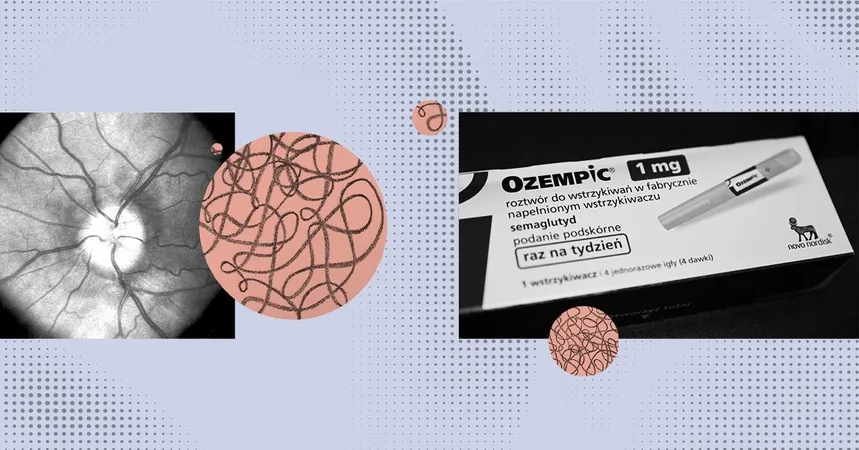
New Studies Link Diabetes Drug Ozempic to Increased Risk of Optic Nerve Damage: What You Need to Know
2025-01-02
Author: John Tan
Recent Findings
Recent research from the University of Southern Denmark has raised alarm bells regarding the diabetes medication Ozempic, suggesting that it may double the risk of Non-Arteritic Anterior Ischemic Optic Neuropathy (NAION), a rare yet serious condition that jeopardizes optic nerve health.
Study Data and Results
Studies utilizing extensive data from Danish and Norwegian health registries corroborate earlier findings from a smaller American study, significantly raising concerns among diabetes patients and healthcare professionals alike. While the absolute risk of developing NAION remains relatively low, researchers advocate for informed discussions between doctors and patients about the potential benefits and risks associated with Ozempic.
Detailed Research Analysis
In the first study, researchers examined data from 424,152 individuals with type 2 diabetes, concluding that Ozempic use indeed doubled the risk of this condition—which can lead to sudden vision loss due to compromised blood flow to the optic nerve. The subsequent study, which is awaiting peer review, further confirmed this association by comparing patients on Ozempic with those using alternative diabetes treatments.
Expert Opinions
Lead researcher Anton Pottegård emphasized, “Our findings are significant because they illustrate an increase in cases of NAION among those using semaglutide [the active ingredient in Ozempic] compared to other antidiabetic therapies.” He cautioned, however, that not all patients should abandon Ozempic; untreated diabetes often leads to more common eye issues, albeit typically less severe than NAION.
Manufacturer's Response
Representatives from Novo Nordisk, the drug's manufacturer, downplayed the findings, asserting that NAION is classified as a rare occurrence and not listed as an adverse reaction on Ozempic’s safety profile. They pointed out that while the relative risk appears to double, the absolute risk remains minimal: for instance, only 2 out of 10,000 patients on semaglutide developed NAION compared to 1 in the control group.
Implications for Patients
The researchers stress that the short-term implications for the majority of patients are limited, and that continuing treatment with Ozempic is advisable for those without previous eye issues. However, individuals experiencing any vision problems potentially linked to NAION should consult a doctor promptly.
Ongoing Monitoring Encouraged
Experts not directly involved in the studies echoed these sentiments. Dr. Benjamin Bert, an ophthalmologist, noted that these findings highlight the ongoing need to understand the complete spectrum of Ozempic’s side effects. He called for careful consideration of the medications prescribed, emphasizing the balance of risks versus benefits.
Conclusion and Recommendations
Furthermore, healthcare professionals are advocating for continued monitoring and open dialogues between patients and their providers. As Dr. Howard Krauss pointed out, type 2 diabetes itself is a known risk factor for NAION, suggesting the need for a nuanced approach to treatment decisions. He cautioned against creating undue fear surrounding medications that significantly reduce diabetes-related health complications.
As ongoing research delves into the underlying mechanisms behind this potential side effect, experts believe further studies could illuminate which patients might be more prone to this issue, helping to tailor diabetes management more safely and effectively.
Be sure to stay updated as new evidence emerges and consult with your healthcare team if you're on Ozempic to ensure the best treatment path for your health!


 Brasil (PT)
Brasil (PT)
 Canada (EN)
Canada (EN)
 Chile (ES)
Chile (ES)
 Česko (CS)
Česko (CS)
 대한민국 (KO)
대한민국 (KO)
 España (ES)
España (ES)
 France (FR)
France (FR)
 Hong Kong (EN)
Hong Kong (EN)
 Italia (IT)
Italia (IT)
 日本 (JA)
日本 (JA)
 Magyarország (HU)
Magyarország (HU)
 Norge (NO)
Norge (NO)
 Polska (PL)
Polska (PL)
 Schweiz (DE)
Schweiz (DE)
 Singapore (EN)
Singapore (EN)
 Sverige (SV)
Sverige (SV)
 Suomi (FI)
Suomi (FI)
 Türkiye (TR)
Türkiye (TR)
 الإمارات العربية المتحدة (AR)
الإمارات العربية المتحدة (AR)